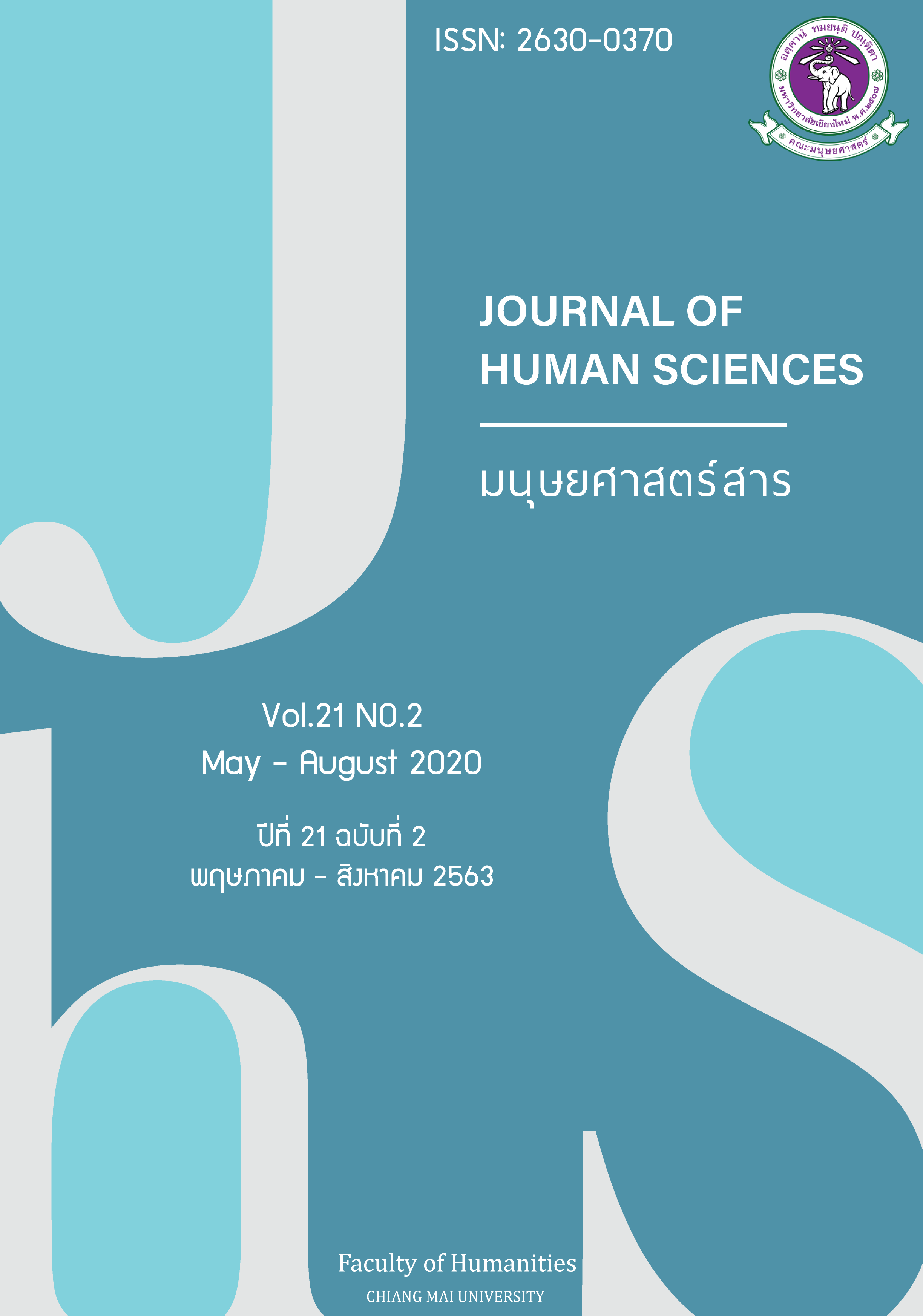บทบาททางเพศของผู้หญิงในภาพยนตร์โฆษณาทางโทรทัศน์ของประเทศญี่ปุ่น ระหว่างปีค.ศ. 2001 - 2019: วาทกรรมวิเคราะห์เชิงวิพากษ์
Main Article Content
บทคัดย่อ
บทความนี้มีวัตถุประสงค์เพื่อศึกษาบทบาททางเพศของผู้หญิงในตัวบท (Text) ทั้งที่เป็นวัจนภาษาและตัวบททางสายตา ที่ถูกนำเสนอในภาพยนตร์โฆษณาทางโทรทัศน์ของประเทศญี่ปุ่นทั้งก่อนและหลังจากที่นายชินโซะ อาเบะ นายกรัฐมนตรีญี่ปุ่นเข้ามาบริหารงาน รวมทั้งเพื่อศึกษาว่าสื่อโฆษณานำเสนอบทบาททางเพศของผู้หญิงให้เป็นไปในแนวทางเดียวกันกับนโยบาย “Womenomics” ซึ่งเป็นนโยบายที่แสดงความคาดหวังของภาครัฐมีต่อผู้หญิงญี่ปุ่นในปัจจุบันหรือไม่ ผลการวิจัยพบว่าก่อนการเข้ามาบริหารงานของนายชินโซะ อาเบะ ปรากฎวาทกรรม คือ (1) วาทกรรมผู้ชายทำงาน ผู้หญิงดูแลบ้าน (2) วาทกรรมโลกของผู้หญิงคือความสัมพันธ์กับผู้คนรอบๆ ตัว (3) วาทกรรมผู้หญิงอยู่ลำดับล่างสุดของสังคมการทำงาน หลังการเข้ามาบริหารงานปรากฏวาทกรรม คือ (1) ผู้ชายเป็นตัวจริง ผู้หญิงเป็นมือใหม่สังคมการทำงาน (2) วาทกรรมผู้หญิงมองเห็นคุณค่าของตนเองผ่านผู้ชาย (3) วาทกรรมหน้าที่ของแม่คือการเลี้ยงลูก (4) วาทกรรมบทบาทผู้ชายแบบขงจื๊อ จากการศึกษาตัวบทช่วยยืนยันแนวคิดของ Fairclough ว่าวาทกรรมแอบแฝงอยู่ในตัวบทอย่างแนบเนียนจนไม่สามารถสังเกตเห็นได้ง่าย ต้องมีการศึกษาตัวบทอย่างเป็นระบบ รวมทั้งผลการศึกษายังสะท้อนให้เห็นว่า สื่อโฆษณานำเสนอประสบการณ์ของผู้หญิงในโลกแห่งการทำงานเพียงผิวเผินเท่านั้น ในทางตรงกันข้าม สื่อกลับผลิตซ้ำบทบาทชายหญิงแบบดั้งเดิมอย่างเข้มข้นแม้ในยุคที่มีการผลักดันนโยบายเพื่อเพิ่มบทบาทของผู้หญิงในสังคม
Article Details
เอกสารอ้างอิง
Abe, S. (2013a). Address by Prime Minister Shinzo Abe, at The Sixty-Eighth Session of The General Assembly of The United Nations. Retrieved from
http://japan.kantei.go.jp/96_abe/statement/201309/26generaldebate _e.html.
Abe, S. (2013b). Shinzo Abe: Unleashing the Power of ‘Womenomics.’ The Wall Street Journal, 1–2. Retrieved from http://www.wsj.com/articles/SB10001424052702303759604579091680931293404
Ajinomoto 味の素. (2003). rưdu baimai ruang supmiso khong mæ [秋・母のみそ汁].
Retrieved from https://www.youtube.com/watch?v=6zelJx_pWOk
Ajinomoto 味の素. (2003). rưdu nao cha tængngan kha [冬・結婚します]. Retrieved from https://www.youtube.com/watch?v=9XbYABBmS6U
Alpine Company アルファイン. (2008). samphat ngan [面接]. Retrieved from https://www.youtube.com/watch?v=WgBGJ5CRtlA
Aroonmanakun, W. (2015). thritsadi phasasat [Linguistics Theory]. Bangkok: Chulalongkorn University.
Cannon Marketing Japan キャノンマーケティングジャパン. (2016). di na thi mi rup [写真っていいね]. Retrieved from https://www.youtube.com/watch?v=lcJxcfi2JlM
Carter, C., & Steiner, L. (2004). Critical Readings: Media and Gender. Berkshire: Open University Press.
Dentsu Advertising Awards Screening Committee 広告電通賞審議会. (2018). What is the Dentsu Advertising Award [広告電通賞とは」電通賞ホームページ]. Retrieved from https://adawards.dentsu.jp/about/
Ezaki Glico Company 江崎グリコ. (2008). phop kan ik khrang [再会]. Retrieved from https://www.youtube.com/watch?v=8Kl1y-B5qsQ
Fairclough, N. (1989). Language and power. London: Longman.
Fairclough, N. (2003). Analysing discourse: Textual analysis for social research. London: Routledge.
Fujita, Y. 藤田由美子. (1996). Analysis of female and male images appearing on TV and anime programs [テレビ・アニメ番組にあらわれた女性像・男性像の分析]. Journal of Child study, 2(6). 33-46.
Fujita, Y. 藤田由美子. (2003). Gender in Mass Media for Children: An Analysis of Television and Books [子供向けマス・メディアに描かれたジェンダーーテレビと絵本の分析ー]. Department of social welfare planning, 4. 259–268.
Furnham, A., & Imadzu, E. (2002). Gender portrayal in British and Japanese TV advertisements. Communications, 27(3). 319-348.
Gender Equality Bureau Cabinet Office 内閣府男女共同参画局. (2011). Gender equality awareness and efforts [メディアにおける女性の参画に関する調査]. n.d.
Halliday, M. A. . (2014). Halliday’s Introduction to Functional Grammar (4th ed.). London: Taylor & Francis Group.
Japan Medical Association 社団法人日本医師会. (2008). phæt wen [勤務医・男性医師]. Retrieved from https://www.nicovideo.jp/watch/sm12140541
Koyama, S 小山静子. (1991). The Norm of Good Wife Kenmo (Japanese) [良妻賢母という規範』勁草書房. n.d.
Levonian, M. (2013). Contemporary Women’s Employment in Japan: The Effe cts of State-Mandated Gender Roles, Wars, and Japan, Inc. Retrieved from http://scholarship.claremont.edu/cmc_the%0Ases/618
Lui, Y. 劉艶. (2009). The communication Function of Vocative Terms in Virtual Communication: from the Viewpoint of Politeness Theory [バーチャル世界における呼びかけ語のコミュニケーション機能 ーポライトネス理論の観点からの考察ー]. Bulletin of Hokuriku University, 33. 173–186.
Nippon Life Insurance 日本生命保険. (2005). fon yam yen [夕立]. Retrieved from https://www.youtube.com/watch?v=TdWqQBEfYS8
Nisshin Foods Holdings 日清食品ホールディングス. (2013). yuk namkhæng hæng kan hangan [就職氷河期]. Retrieved from https://www.youtube.com/watch?v=E0DhbyXs_FE
Nobushima, A. 延島明恵. (1999). Study on Gender Description and Communication Effect in TV Advertising [テレビ広告における ジェンダー描写とコミュニケーション効果に関する研究]. Studies in sociology, psychology and education, 50. 42–46.
NTT Docomo ドコモ. (2016). dTV chưam yong rưangrao khong song rao [dTVふたりをつなぐ物語]. Retrieved from https://www.youtube.com/watch?v=IYX68Br1d2w
NTT Docomo ドコモ. (2017). rưdu ron yisipha pi hailang [25年後の夏]. Retrieved from https://adawards.dentsu.jp/prize/detail/7812
Oka, Y 岡ヤス子. (1980). An Inquiry into the Women’s Education (7th report): The Women’s Education in Edo Era. Bulletin of Hiroshima Bunka Women's Junior College, 13. 37–50.
Panasonic Corporationパナソニック株式会社. (2018). ran khrưang chai faifa nai mưang cha hai borikan to pai [街のでんきやさんはつづく]. Retrieved from https://ps-hp.jpn.panasonic.com/ps/other/advertisement/
Pilot Corporation パイロットコーポレーション. (2012). chak khro̜pkhrua pai tham ngan [書く、を支える。「単身赴任」」]. Retrieved from https://www.youtube.com/watch?v=hnc7-IGEJuI
Pola ポーラ. (2014). Call Her Name. Retrieved from https://www.youtube.com/watch?v=1ibP-IaX0l4
Pongsapitaksanti, P. ポンサピタックサンティ・ピヤ. (2008). Gender and Labor Role in TV Advertising From a Comparison between Japan and Thailand [テレビ広告におけるジェンダーと労働役割 ー日本とタイの比較からー]. Sociology Study Group, 11. 15-27.
Recruit Sumai Company リクルート住まいカンパニー. (2015a). phap chai sutthai (naksưksa khru) [最後の上映 (先生)]. Retrieved from https://www.youtube.com/watch?v=245YbM8A42k
Recruit Sumai Company リクルート住まいカンパニー. (2015b). phap chai sutthai [最後の上映 (看護婦)]. Retrieved from https://www.youtube.com/watch?v=N_OK2k1-dHQ
Saito, Y. (2014). Gender Equality in Education in Japan. Retrieved from http://www.nier.go.jp/English/educationjapan/pdf/201403GEE.pdf
Sakamoto, A., Kitou, M., Takahira, M., & Adachi, N 坂元章、鬼頭真澄、高比良美詠子、足立にれか. (2003). A Content Analysis of Gender Stereotyped Portrayals in Television Commercials: How Have They Changed over the Thirty-Three Years? [テレビ・コマーシャルにおける性ステレオタイプ的描写の内容分析研究ー33年でどれだけ変化したかー]. Journal of gender studies, 6. 47–57.
Shelton, J. A. (2006). Female Labor in The Postwar Japnese Economy: A Geographic Perspective. (Doctoral dissertation, The Ohio State University).
Suntory Holdings サントリーホールディングス. (2006). pho ma tokiao [父の上京]. Retrieved from https://www.youtube.com/watch?v=36tYjus4n8U
Suntory Holdings サントリーホールディングス. (2007). wan kœt khong pho [父の誕生日]. Retrieved from https://www.youtube.com/watch?v=G5GOL4Tn_mQ
Suntory Holdings サントリーホールディングス. (2008). khon rak khong luk sao [娘の相手]. Retrieved from https://www.youtube.com/watch?v=qt0pBtjxz98
Tatsuki, M. 龍城正明. (2008). A system network of Japanese process types: a semanticization of Japanese verbs and adjectives through the Kyoto grammar approach [日英語の過程型に関する考察 ーThe Kyoto Grammar による日本語過程型分析ー]. Doshisha University English Literature Studies, 38. 69–98.
Thermos サーモス. (2016). Thermos Brand Movie [サーモスブランドムービー]. Retrieved from https://adawards.dentsu.jp/prize/detail/6527
Tokyo Gas 東京ガス. (2009). saisamphan khro̜pkhrua khaophat fimư pho [家族の絆・お父さんのチャーハン]. Retrieved from https://www.youtube.com/watch?v=UiKSFqnZYVc
Tokyo Gas 東京ガス. (2010). saisamphan khro̜pkhrua chotmai nai khao klong [家族の絆・お弁当メール]. Retrieved from https://www.youtube.com/watch?v=Xgp3aPR-llM
Tokyo Gas 東京ガス. (2014). sing mi chiwit thi riak wa mæ [母とは]. Retrieved from https://www.youtube.com/watch?v=pnZr3tQTjWg
TOTO トートー. (2014). bækthiria pho luk [菌の親子]. Retrieved from https://www.youtube.com/watch?v=eiZGu15YG78
World Economic Forum (2020). Global Gender Gap Report 2020. Retrieved from http://www3.weforum.org/docs/WEF_GGGR_2020.pdf


